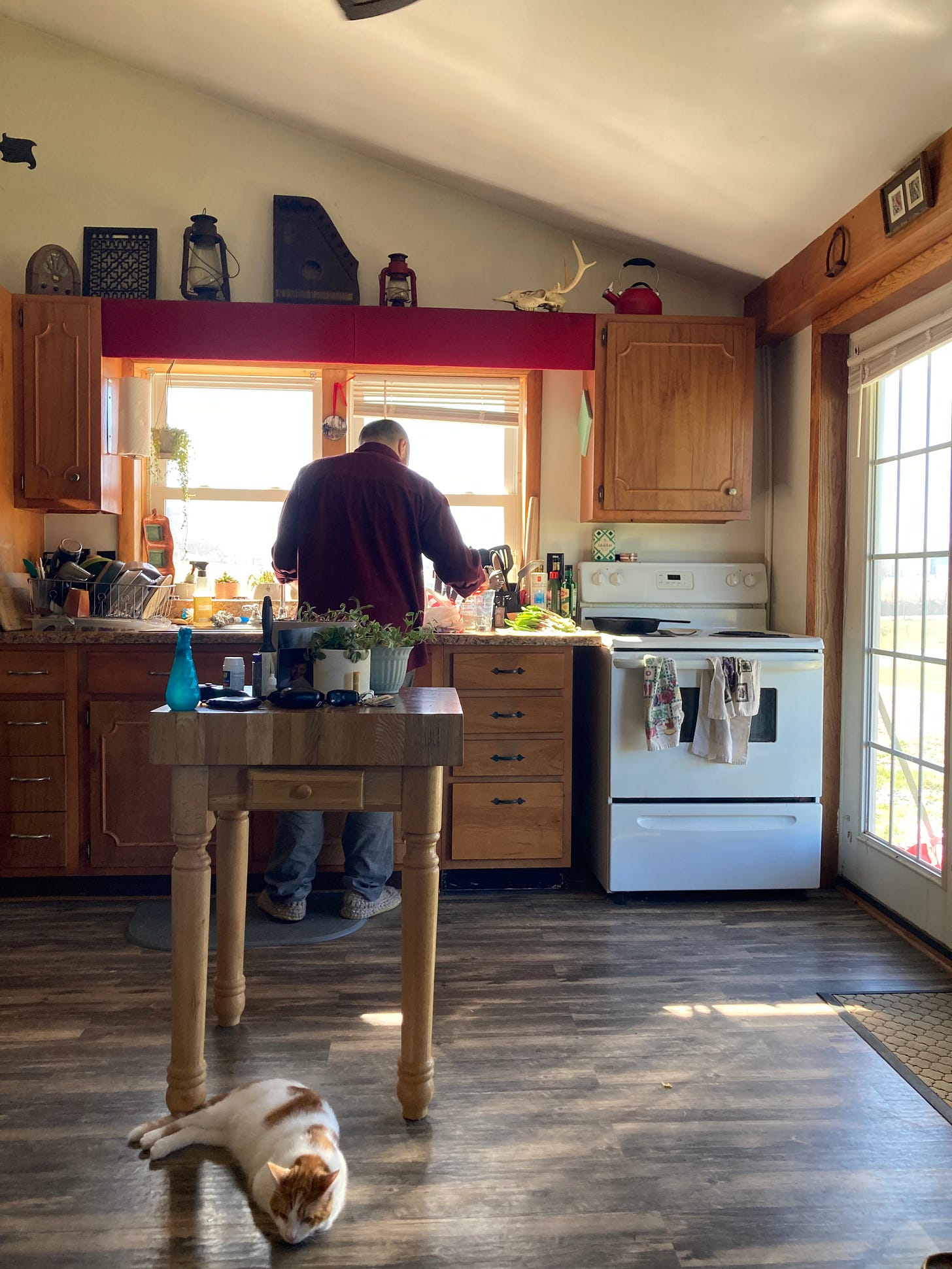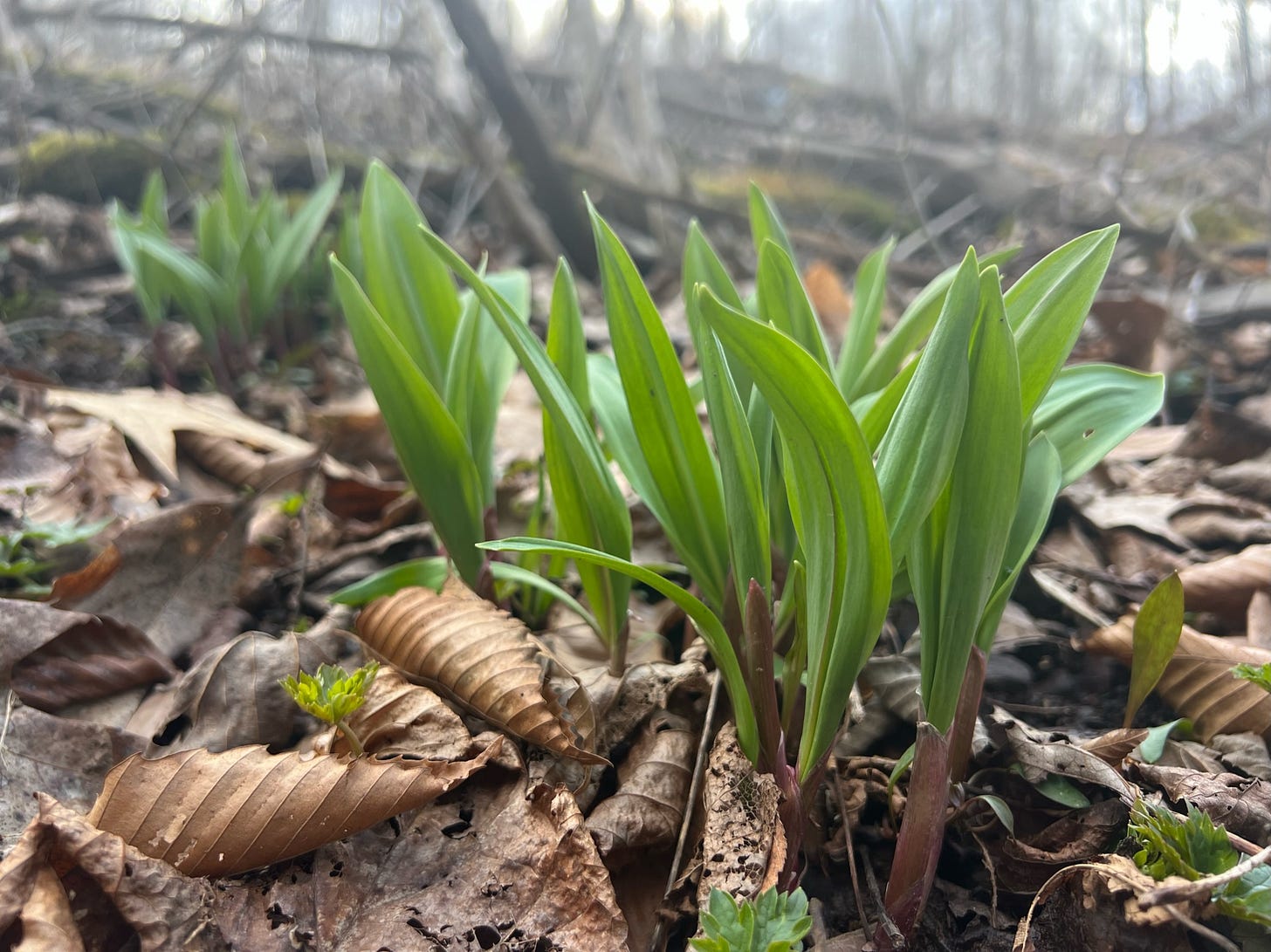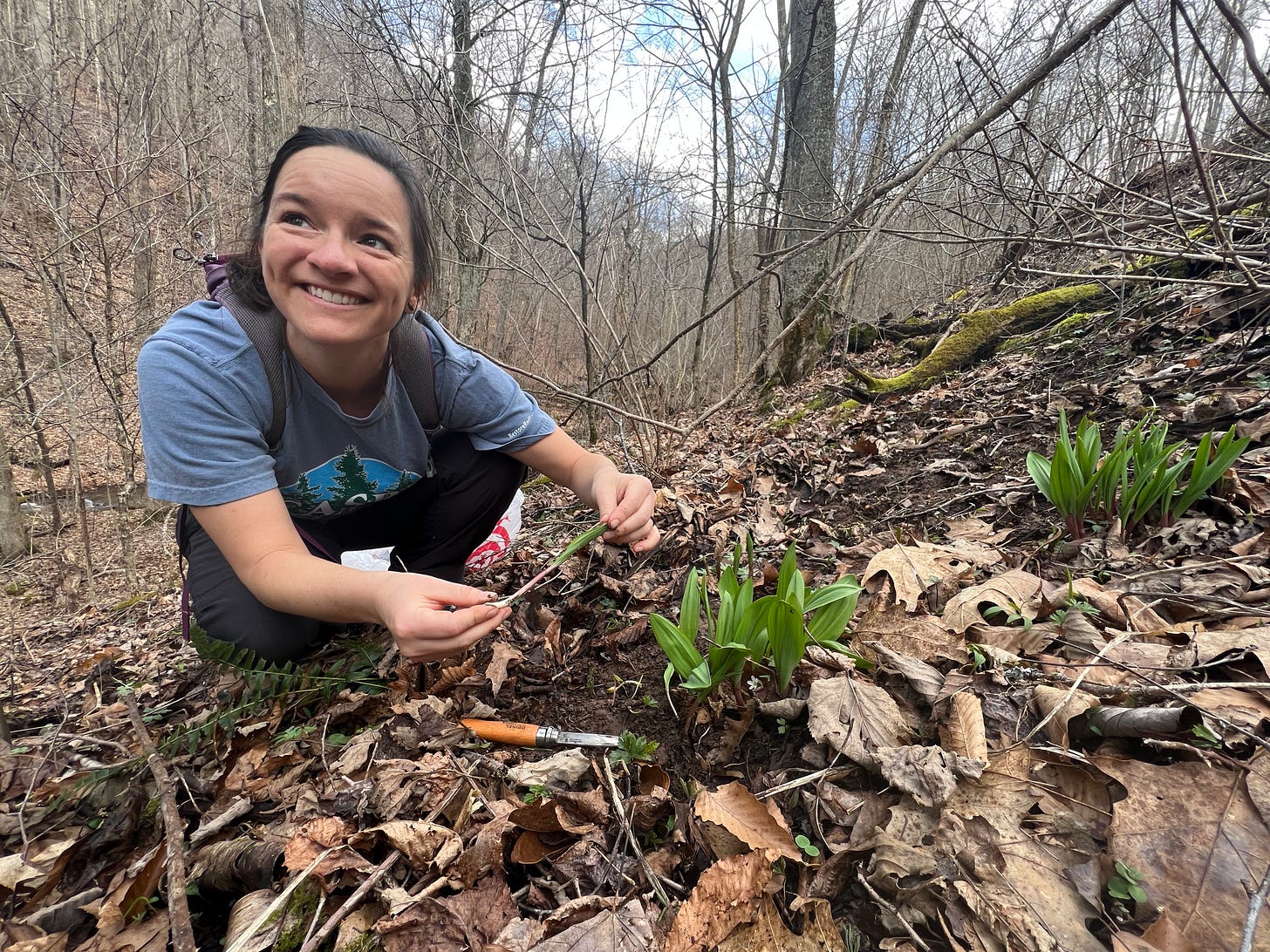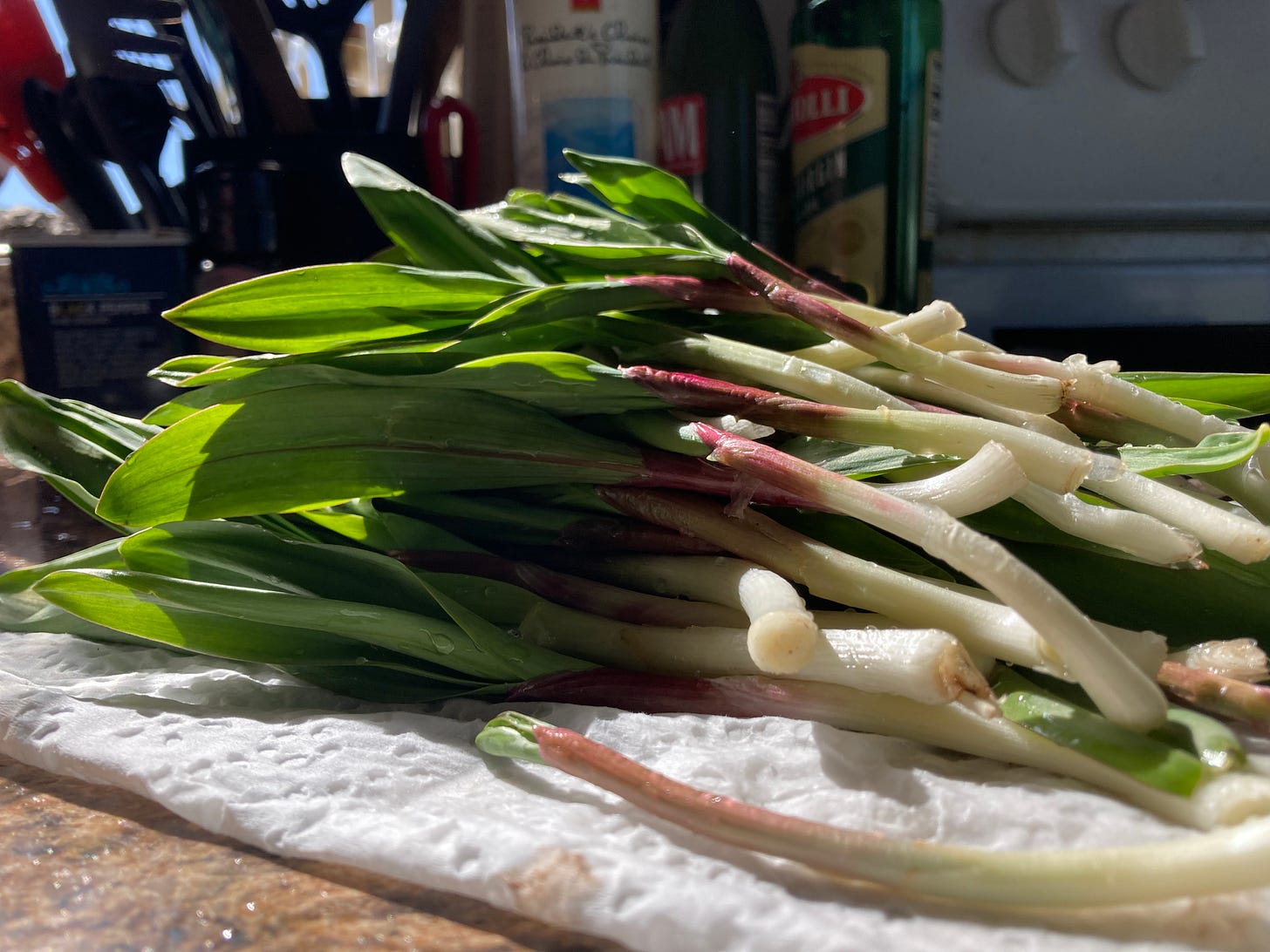The Muddiest, Muckiest, Most Fickle Season
field notes from the first of springtime foraging, RAMPS
Tonight at dinner Mike rubbed a thumb over a mysterious shiny patch on my forearm: ambient glitter leftover from his birthday party weeks ago. The way that shit lingers! We’ve cleared out the gold tinsel, the party hats, and just recently burned the tattered remains of the unicorn pinata. But the glitter persists, a sweet and stubborn reminder of gathering and celebration.
Otherwise, our house is quiet in the aftermath of such vivid festivities. I’m grateful for it, for a chance to regain a sense of rhythm and peace in our everyday lives. We’re deep in the planning stages of an enormous garden, and talking about chickens, too. Our kitties are adjusting, mostly—Panchito, our chirpy orange tabby, purrs like a motorboat when he winds his way around our shins in a figure-eight. His sister, Dougie, a sweet tuxedo kitty, is making progress in emerging from beneath the couch (though admittedly, only at midnight.) Generally speaking, we are happy and content in our daily activities and adventures.
So how, then, do I talk about emotional upset without stirring up alarm or contradicting myself? Life is good lately, deeply good. And yet, isn’t life just this way—there is always some new thing around the corner, some curve-ball or challenge or something. Again—it’s challenging to know how to talk about this. On the one hand, protecting the tender circumstances of my private life is of utmost concern, especially as a recovering over-sharer. Intimate details simply aren’t appropriate for a public newsletter (something I’ve learned the hard way already, in unwittingly crossing that line and revealing too much.) But on the other hand, transparency & honesty are incredibly important to me. I believe we benefit one another when we tell the truth about how things really feel. Especially when they’re hard. This doesn’t make us weak, helpless, pitiful or desperate. It’s just, the truth.
So without getting into all the hairy details, I’ll summarize simply by saying that change is hard. Even when it’s welcome change, and even when you’re fully aware and doing your best to cope, it’s still effing hard. It is especially fitting to reminded of this natural fact in the midst of spring, the muckiest, muddiest, most fickle of seasons. As James Bridle wrote, shared by Krista in a most recent OnBeing episode, “life is soupy, mixed up, and tumultuous. Muddying the waters is precisely the point because it’s from such nutritious streams that life grows.” No mud, no lotus, etc etc etc (but, really!)
What I’m really interested to talk about here is, what helps and what I’m carrying with me through the muck. In particular, adjusting my scope has proved immensely helpful in the face of change: wide lens for my feelings and zoom lens when I’m working, outside, or in the world generally. A narrow field of vision does not help when you’re in the emotional trenches, but it does help, for example, to spy the particular, pure green of ramps.
Ramps—West Virginia’s deliciously funky, pungent harbinger of spring—have started popping up here in green patches so vivid they appear illuminated from within. From a distance, ramps are not entirely dissimilar to daffodils or lilies. (A quick word to the wise, do not mistake them for lily of the valley, their toxic lookalikes.) I’ve made it a point now, on hikes and woodsy walks, to dial in my sight for their leafy pockets of kelly green tucked in hollows of brown. Even with this adjusted, heightened sense though, they can be despairingly elusive.
Persisting the search despite despair makes ramping a kind of meditation + faith practice. Certainly, this practice depends on a basic understanding of identifying characteristics and ideal growth conditions, but ultimately it is rooted in careful attention and patient faith all the same. In general, foraging encourages a slower pace and closer focus which, in the context of seeking out tasty wild treats, is deeply soothing. Indeed, that calm, attentive approach is instructive for life outside the forest too, an embodied metaphor for how to manage trying circumstances. The way may be covered in thorny brambles, steeply graded and muddy-slick, but we’d do well to steady our breath and stay the course: you really never know what’s just around the corner.
This deep brand of patience and steadiness makes the first glimpse of discovery feel like a revelation. A bolt of green shoots out from the mind-numbing sea of brown; a surge of excitement; disbelief transformed into sudden joy: ramps! They are nonchalant, having been there the whole time, but for the forager it is like stumbling upon a magic portal. Because once you find one patch, it is almost certain more are very close by. The despairing search becomes a giddy, oft-rewarded treasure hunt, complete with a delightfully muddy, careful excavation of “the loot.” (Another word to the wise, for fellow rampers: a clean cut an 1/8th of an inch from the root encourages future growth, as does harvesting only one quarter of each patch found.) Ramp patches appear like serendipitous green-lights glowing sequentially in a row, each one just a step ahead, right when and where you need them. I’m not a religious person by any stretch, but I bet this is what faith restored feels like.
I can’t help but think of the saying, “what you focus on, grows”—a concept which applies to both foraging and psychology, as my friend Amanda wrote over at her substack most recently. As much as I hedge to admit it, I was a nonbeliever when Mike brought me to the edge of the Monongahela for ramping. I had a scarcity mindset, doubting the likelihood of discovery and wondering if we shouldn’t just snag a few ramps from our neighbor’s patch (yes I know this way of thinking is liable to get me shot one day, if I’m not careful; we’ll talk about perspectives on private land another time.) But once sighted, I started to see them everywhere: ramps on ramps on glorious ramps, cropping up in miraculous abundance on the steep northern side of the creek.
I take lessons from sessions like these in the woods. The surrounding spaciousness opens me up, allowing my body-mind access to a quieter, more grounded knowledge. It is beyond me to fully explain it, and I don’t know that I care to. It is enough to know, and honor, my need for the clear, the cool and the green, especially when the hot, angry tug of emotional gravity threatens to drag me down. For all the bullshit that astrology may be, I find some comfort in remembering the characteristics of fiery Aries season, happening now: unapologetically impatient, energetic, passionate and blunt. Without getting too far into it, all I’ll say here is—that tracks for me lately.
Certainly, there is an abundance of metaphorical teaching from this most recent ramp forage, specifically. Given that it came on the heels of intense spring fever + emotional intensity, the simple innocence and joy of discovery alone was a balm to my soul. I needed a visceral reminder that regeneration comes from the dark, dank fecundity of soil. Emergence of new life arrives with the light predictably, every spring. The growth doesn’t stop—it’s cyclical, repeating. And just as it must be a struggle for those first tender, creamy-white ramp shoots to strive upwards from under the cover of leaves, so too it is for us in any transition. Discomfort is a sign of many things, to be sure, but it most certainly always accompanies growth.
So I am training myself to look for the good in the midst of a season of growth, knowing that, while discomfort clamors for attention, it is by no means the only thing. I monitor the efficacy of this approach—looking for the good—the same way I do when scanning for ramps, by asking: am I finding what I’m looking for? Are there signs which indicate this to be a worthy path? Do I have the patience to stay this course? Or do I maybe need to look somewhere else? To be clear, I am not applying these questions literally or outwardly, but more figuratively and inwardly, toward my emotional landscape and psychology. There is that saying, you know the one: wherever you go, there you are. Bearing this in mind, I’m adjusting my scope as of late, assessing my ratio of flexibility : stagnancy, and drawing sustenance from the natural world—both literally and figuratively, in this case—for myself, my relationships, and my life.
The force that through the green fuse drives the flower
Drives my green age; that blasts the roots of trees
Is my destroyer.
And I am dumb to tell the crooked rose
My youth is bent by the same wintry fever.-Dylan Thomas







